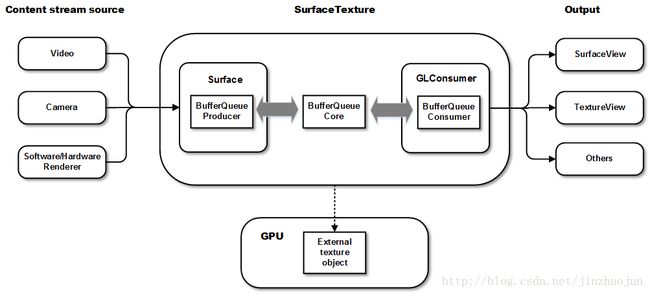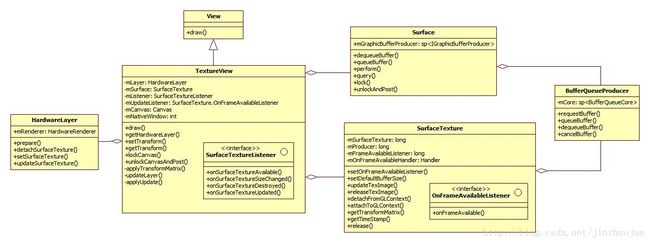SurfaceView, GLSurfaceView, SurfaceTexture以及TextureView是Android当中名字比较绕,关系又比较密切的几个类。本文基于Android 5.0(Lollipop)的代码理一下它们的基本原理,联系与区别。
SurfaceView
SurfaceView从Android 1.0(API level 1)时就有 。它继承自类View,因此它本质上是一个View。但与普通View不同的是,它有自己的Surface。我们知道,一般的Activity包含的多个View会组成View hierachy的树形结构,只有最顶层的DecorView,也就是根结点视图,才是对WMS可见的。这个DecorView在WMS中有一个对应的WindowState。相应地,在SF中对应的Layer。而SurfaceView自带一个Surface,这个Surface在WMS中有自己对应的WindowState,在SF中也会有自己的Layer。如下图所示:
也就是说,虽然在App端它仍在View hierachy中,但在Server端(WMS和SF)中,它与宿主窗口是分离的。这样的好处是对这个Surface的渲染可以放到单独线程去做,渲染时可以有自己的GL context。这对于一些游戏、视频等性能相关的应用非常有益,因为它不会影响主线程对事件的响应。但它也有缺点,因为这个Surface不在View hierachy中,它的显示也不受View的属性控制,所以不能进行平移,缩放等变换,也不能放在其它ViewGroup中,一些View中的特性也无法使用。
GLSurfaceView
GLSurfaceView从Android 1.5(API level 3)开始加入,作为SurfaceView的补充。它可以看作是SurfaceView的一种典型使用模式。在SurfaceView的基础上,它加入了EGL的管理,并自带了渲染线程。另外它定义了用户需要实现的Render接口,提供了用Strategy pattern更改具体Render行为的灵活性。作为GLSurfaceView的Client,只需要将实现了渲染函数的Renderer的实现类设置给GLSurfaceView即可。如:
public class TriangleActivity extends Activity {
protected void onCreate(Bundle savedInstanceState) {
mGLView = new GLSurfaceView(this);
mGLView.setRenderer(new RendererImpl(this));
相关类图如下。其中SurfaceView中的SurfaceHolder主要是提供了一坨操作Surface的接口。GLSurfaceView中的EglHelper和GLThread分别实现了上面提到的管理EGL环境和渲染线程的工作。GLSurfaceView的使用者需要实现Renderer接口。
SurfaceTexture
SurfaceTexture从Android 3.0(API level 11)加入。和SurfaceView不同的是,它对图像流的处理并不直接显示,而是转为GL外部纹理,因此可用于图像流数据的二次处理(如Camera滤镜,桌面特效等)。比如Camera的预览数据,变成纹理后可以交给GLSurfaceView直接显示,也可以通过SurfaceTexture交给TextureView作为View heirachy中的一个硬件加速层来显示。首先,SurfaceTexture从图像流(来自Camera预览,视频解码,GL绘制场景等)中获得帧数据,当调用updateTexImage()时,根据内容流中最近的图像更新SurfaceTexture对应的GL纹理对象,接下来,就可以像操作普通GL纹理一样操作它了。从下面的类图中可以看出,它核心管理着一个BufferQueue的Consumer和Producer两端。Producer端用于内容流的源输出数据,Consumer端用于拿GraphicBuffer并生成纹理。SurfaceTexture.OnFrameAvailableListener用于让SurfaceTexture的使用者知道有新数据到来。JNISurfaceTextureContext是OnFrameAvailableListener从Native到Java的JNI跳板。其中SurfaceTexture中的attachToGLContext()和detachToGLContext()可以让多个GL context共享同一个内容源。
Android 5.0中将BufferQueue的核心部分分离出来,放在BufferQueueCore这个类中。BufferQueueProducer和BufferQueueConsumer分别是它的生产者和消费者实现基类(分别实现了IGraphicBufferProducer和IGraphicBufferConsumer接口)。它们都是由BufferQueue的静态函数createBufferQueue()来创建的。Surface是生产者端的实现类,提供dequeueBuffer/queueBuffer等硬件渲染接口,和lockCanvas/unlockCanvasAndPost等软件渲染接口,使内容流的源可以往BufferQueue中填graphic buffer。GLConsumer继承自ConsumerBase,是消费者端的实现类。它在基类的基础上添加了GL相关的操作,如将graphic buffer中的内容转为GL纹理等操作。到此,以SurfaceTexture为中心的一个pipeline大体是这样的:
TextureView
TextureView在4.0(API level 14)中引入。它可以将内容流直接投影到View中,可以用于实现Live preview等功能。和SurfaceView不同,它不会在WMS中单独创建窗口,而是作为View hierachy中的一个普通View,因此可以和其它普通View一样进行移动,旋转,缩放,动画等变化。值得注意的是TextureView必须在硬件加速的窗口中。它显示的内容流数据可以来自App进程或是远端进程。从类图中可以看到,TextureView继承自View,它与其它的View一样在View hierachy中管理与绘制。TextureView重载了draw()方法,其中主要把SurfaceTexture中收到的图像数据作为纹理更新到对应的HardwareLayer中。SurfaceTexture.OnFrameAvailableListener用于通知TextureView内容流有新图像到来。SurfaceTextureListener接口用于让TextureView的使用者知道SurfaceTexture已准备好,这样就可以把SurfaceTexture交给相应的内容源。Surface为BufferQueue的Producer接口实现类,使生产者可以通过它的软件或硬件渲染接口为SurfaceTexture内部的BufferQueue提供graphic buffer。
实例解读
下面以VideoDumpView.java(位于/frameworks/base/media/tests/MediaDump/src/com/android/mediadump/)为例分析下SurfaceTexture的使用。这个例子的效果是从MediaPlayer中拿到视频帧,然后显示在屏幕上,接着把屏幕上的内容dump到指定文件中。因为SurfaceTexture本身只产生纹理,所以这里还需要GLSurfaceView配合来做最后的渲染输出。
首先,VideoDumpView是GLSurfaceView的继承类。在构造函数VideoDumpView()中会创建VideoDumpRenderer,也就是GLSurfaceView.Renderer的实例,然后调setRenderer()将之设成GLSurfaceView的Renderer。
109 public VideoDumpView(Context context) {
...
116 mRenderer = new VideoDumpRenderer(context);
117 setRenderer(mRenderer);
118 }
随后,GLSurfaceView中的GLThread启动,创建EGL环境后回调VideoDumpRenderer中的onSurfaceCreated()。
519 public void onSurfaceCreated(GL10 glUnused, EGLConfig config) {
...
551 // Create our texture. This has to be done each time the surface is created.
552 int[] textures = new int[1];
553 GLES20.glGenTextures(1, textures, 0);
554
555 mTextureID = textures[0];
556 GLES20.glBindTexture(GL_TEXTURE_EXTERNAL_OES, mTextureID);
...
575 mSurface = new SurfaceTexture(mTextureID);
576 mSurface.setOnFrameAvailableListener(this);
577
578 Surface surface = new Surface(mSurface);
579 mMediaPlayer.setSurface(surface);
这里,首先通过GLES创建GL的外部纹理。外部纹理说明它的真正内容是放在ion分配出来的系统物理内存中,而不是GPU中,GPU中只是维护了其元数据。接着根据前面创建的GL纹理对象创建SurfaceTexture。流程如下:
SurfaceTexture的参数为GLES接口函数glGenTexture()得到的纹理对象id。在初始化函数SurfaceTexture_init()中,先创建GLConsumer和相应的BufferQueue,再将它们的指针通过JNI放到SurfaceTexture的Java层对象成员中。
230static void SurfaceTexture_init(JNIEnv* env, jobject thiz, jboolean isDetached,
231 jint texName, jboolean singleBufferMode, jobject weakThiz)
232{
...
235 BufferQueue::createBufferQueue(&producer, &consumer);
...
242 sp surfaceTexture;
243 if (isDetached) {
244 surfaceTexture = new GLConsumer(consumer, GL_TEXTURE_EXTERNAL_OES,
245 true, true);
246 } else {
247 surfaceTexture = new GLConsumer(consumer, texName,
248 GL_TEXTURE_EXTERNAL_OES, true, true);
249 }
...
256 SurfaceTexture_setSurfaceTexture(env, thiz, surfaceTexture);
257 SurfaceTexture_setProducer(env, thiz, producer);
...
266 sp ctx(new JNISurfaceTextureContext(env, weakThiz,
267 clazz));
268 surfaceTexture->setFrameAvailableListener(ctx);
269 SurfaceTexture_setFrameAvailableListener(env, thiz, ctx);
由于直接的Listener在Java层,而触发者在Native层,因此需要从Native层回调到Java层。这里通过JNISurfaceTextureContext当了跳板。JNISurfaceTextureContext的onFrameAvailable()起到了Native和Java的桥接作用:
180void JNISurfaceTextureContext::onFrameAvailable() ... 184 env->CallStaticVoidMethod(mClazz, fields.postEvent, mWeakThiz);
其中的fields.postEvent早在SurfaceTexture_classInit()中被初始化为SurfaceTexture的postEventFromNative()函数。这个函数往所在线程的消息队列中放入消息,异步调用VideoDumpRenderer的onFrameAvailable()函数,通知VideoDumpRenderer有新的数据到来。 回到onSurfaceCreated(),接下来创建供外部生产者使用的Surface类。Surface的构造函数之一带有参数SurfaceTexture。
133 public Surface(SurfaceTexture surfaceTexture) {
...
140 setNativeObjectLocked(nativeCreateFromSurfaceTexture(surfaceTexture));
它实际上是把SurfaceTexture中创建的BufferQueue的Producer接口实现类拿出来后创建了相应的Surface类。
135static jlong nativeCreateFromSurfaceTexture(JNIEnv* env, jclass clazz,
136 jobject surfaceTextureObj) {
137 sp producer(SurfaceTexture_getProducer(env, surfaceTextureObj));
...
144 sp surface(new Surface(producer, true));
这样,Surface为BufferQueue的Producer端,SurfaceTexture中的GLConsumer为BufferQueue的Consumer端。当通过Surface绘制时,SurfaceTexture可以通过updateTexImage()来将绘制结果绑定到GL的纹理中。 回到onSurfaceCreated()函数,接下来调用setOnFrameAvailableListener()函数将VideoDumpRenderer(实现SurfaceTexture.OnFrameAvailableListener接口)作为SurfaceTexture的Listener,因为它要监听内容流上是否有新数据。接着将SurfaceTexture传给MediaPlayer,因为这里MediaPlayer是生产者,SurfaceTexture是消费者。后者要接收前者输出的Video frame。这样,就通过Observer pattern建立起了一条通知链:MediaPlayer -> SurfaceTexture -> VideDumpRenderer。在onFrameAvailable()回调函数中,将updateSurface标志设为true,表示有新的图像到来,需要更新Surface了。为毛不在这儿马上更新纹理呢,因为当前可能不在渲染线程。SurfaceTexture对象可以在任意线程被创建(回调也会在该线程被调用),但updateTexImage()只能在含有纹理对象的GL context所在线程中被调用。因此一般情况下回调中不能直接调用updateTexImage()。 与此同时,GLSurfaceView中的GLThread也在运行,它会调用到VideoDumpRenderer的绘制函数onDrawFrame()。
372 public void onDrawFrame(GL10 glUnused) {
...
377 if (updateSurface) {
...
380 mSurface.updateTexImage();
381 mSurface.getTransformMatrix(mSTMatrix);
382 updateSurface = false;
...
394 // Activate the texture.
395 GLES20.glActiveTexture(GLES20.GL_TEXTURE0);
396 GLES20.glBindTexture(GL_TEXTURE_EXTERNAL_OES, mTextureID);
...
421 // Draw a rectangle and render the video frame as a texture on it.
422 GLES20.glDrawArrays(GLES20.GL_TRIANGLE_STRIP, 0, 4);
...
429 DumpToFile(frameNumber);
这里,通过SurfaceTexture的updateTexImage()将内容流中的新图像转成GL中的纹理,再进行坐标转换。绑定刚生成的纹理,画到屏幕上。整个流程如下:
最后onDrawFrame()调用DumpToFile()将屏幕上的内容倒到文件中。在DumpToFile()中,先用glReadPixels()从屏幕中把像素数据存到Buffer中,然后用FileOutputStream输出到文件。 上面讲了SurfaceTexture,下面看看TextureView是如何工作的。还是从例子着手,Android的关于TextureView的官方文档(http://developer.android.com/reference/android/view/TextureView.html)给了一个简洁的例子LiveCameraActivity。它它可以将Camera中的内容放在View中进行显示。在onCreate()函数中首先创建TextureView,再将Activity(实现了TextureView.SurfaceTextureListener接口)传给TextureView,用于监听SurfaceTexture准备好的信号。
protected void onCreate(Bundle savedInstanceState) {
...
mTextureView = new TextureView(this);
mTextureView.setSurfaceTextureListener(this);
...
}
TextureView的构造函数并不做主要的初始化工作。主要的初始化工作是在getHardwareLayer()中,而这个函数是在其基类View的draw()中调用。TextureView重载了这个函数:
348 HardwareLayer getHardwareLayer() {
...
358 mLayer = mAttachInfo.mHardwareRenderer.createTextureLayer();
359 if (!mUpdateSurface) {
360 // Create a new SurfaceTexture for the layer.
361 mSurface = new SurfaceTexture(false);
362 mLayer.setSurfaceTexture(mSurface);
363 }
364 mSurface.setDefaultBufferSize(getWidth(), getHeight());
365 nCreateNativeWindow(mSurface);
366
367 mSurface.setOnFrameAvailableListener(mUpdateListener, mAttachInfo.mHandler);
368
369 if (mListener != null && !mUpdateSurface) {
370 mListener.onSurfaceTextureAvailable(mSurface, getWidth(), getHeight());
371 }
...
390 applyUpdate();
391 applyTransformMatrix();
392
393 return mLayer;
394 }
因为TextureView是硬件加速层(类型为LAYER_TYPE_HARDWARE),它首先通过HardwareRenderer创建相应的HardwareLayer类,放在mLayer成员中。然后创建SurfaceTexture类,具体流程见前文。之后将HardwareLayer与SurfaceTexture做绑定。接着调用Native函数nCreateNativeWindow,它通过SurfaceTexture中的BufferQueueProducer创建Surface类。注意Surface实现了ANativeWindow接口,这意味着它可以作为EGL Surface传给EGL接口从而进行硬件绘制。然后setOnFrameAvailableListener()将监听者mUpdateListener注册到SurfaceTexture。这样,当内容流上有新的图像到来,mUpdateListener的onFrameAvailable()就会被调用。然后需要调用注册在TextureView中的SurfaceTextureListener的onSurfaceTextureAvailable()回调函数,通知TextureView的使用者SurfaceTexture已就绪。整个流程大体如下:
注意这里这里为TextureView创建了DeferredLayerUpdater,而不是像Android 4.4(Kitkat)中返回GLES20TextureLayer。因为Android 5.0(Lollipop)中在App端分离出了渲染线程,并将渲染工作放到该线程中。这个线程还能接收VSync信号,因此它还能自己处理动画。事实上,这里DeferredLayerUpdater的创建就是通过同步方式在渲染线程中做的。DeferredLayerUpdater,顾名思义,就是将Layer的更新请求先记录在这,当渲染线程真正要画的时候,再进行真正的操作。其中的setSurfaceTexture()会调用HardwareLayer的Native函数nSetSurfaceTexture()将SurfaceTexture中的surfaceTexture成员(类型为GLConsumer)传给DeferredLayerUpdater,这样之后要更新纹理时DeferredLayerUpdater就知道从哪里更新了。 前面提到初始化中会调用onSurfaceTextureAvailable()这个回调函数。在它的实现中,TextureView的使用者就可以将准备好的SurfaceTexture传给数据源模块,供数据源输出之用。如:
public void onSurfaceTextureAvailable(SurfaceTexture surface, int width, int height) {
mCamera = Camera.open();
...
mCamera.setPreviewTexture(surface);
mCamera.startPreview();
...
}
看一下setPreviewTexture()的实现,其中把SurfaceTexture中初始化时创建的GraphicBufferProducer拿出来传给Camera模块。
576static void android_hardware_Camera_setPreviewTexture(JNIEnv *env,
577 jobject thiz, jobject jSurfaceTexture)
...
585 producer = SurfaceTexture_getProducer(env, jSurfaceTexture);
...
594 if (camera->setPreviewTarget(producer) != NO_ERROR) {
到这里,一切都初始化地差不多了。接下来当内容流有新图像可用,TextureView会被通知到(通过SurfaceTexture.OnFrameAvailableListener接口)。SurfaceTexture.OnFrameAvailableListener是SurfaceTexture有新内容来时的回调接口。TextureView中的mUpdateListener实现了该接口:
755 public void onFrameAvailable(SurfaceTexture surfaceTexture) {
756 updateLayer();
757 invalidate();
758 }
可以看到其中会调用updateLayer()函数,然后通过invalidate()函数申请更新UI。updateLayer()会设置mUpdateLayer标志位。这样,当下次VSync到来时,Choreographer通知App通过重绘View hierachy。在UI重绘函数performTranversals()中,作为View hierachy的一分子,TextureView的draw()函数被调用,其中便会相继调用applyUpdate()和HardwareLayer的updateSurfaceTexture()函数。
138 public void updateSurfaceTexture() {
139 nUpdateSurfaceTexture(mFinalizer.get());
140 mRenderer.pushLayerUpdate(this);
141 }
updateSurfaceTexture()实际通过JNI调用到android_view_HardwareLayer_updateSurfaceTexture()函数。在其中会设置相应DeferredLayerUpdater的标志位mUpdateTexImage,它表示在渲染线程中需要更新该层的纹理。
前面提到,Android 5.0引入了渲染线程,它是一个更大的topic,超出本文范围,这里只说相关的部分。作为背景知识,下面只画出了相关的类。可以看到,ThreadedRenderer作为新的HardwareRenderer替代了Android 4.4中的Gl20Renderer。其中比较关键的是RenderProxy类,需要让渲染线程干活时就通过这个类往渲染线程发任务。RenderProxy中指向的RenderThread就是渲染线程的主体了,其中的threadLoop()函数是主循环,大多数时间它会poll在线程的Looper上等待,当有同步请求(或者VSync信号)过来,它会被唤醒,然后处理TaskQueue中的任务。TaskQueue是RenderTask的队列,RenderTask代表一个渲染线程中的任务。如DrawFrameTask就是RenderTask的继承类之一,它主要用于渲染当前帧。而DrawFrameTask中的DeferredLayerUpdater集合就存放着之前对硬件加速层的更新操作申请。
当主线程准备好渲染数据后,会以同步方式让渲染线程完成渲染工作。其中会先调用processLayerUpdate()更新所有硬件加速层中的属性,继而调用到DeferredLayerUpdater的apply()函数,其中检测到标志位mUpdateTexImage被置位,于是会调用doUpdateTexImage()真正更新GL纹理和转换坐标。
最后,总结下这几者的区别和联系。简单地说,SurfaceView是一个有自己Surface的View。它的渲染可以放在单独线程而不是主线程中。其缺点是不能做变形和动画。SurfaceTexture可以用作非直接输出的内容流,这样就提供二次处理的机会。与SurfaceView直接输出相比,这样会有若干帧的延迟。同时,由于它本身管理BufferQueue,因此内存消耗也会稍微大一些。TextureView是一个可以把内容流作为外部纹理输出在上面的View。它本身需要是一个硬件加速层。事实上TextureView本身也包含了SurfaceTexture。它与SurfaceView+SurfaceTexture组合相比可以完成类似的功能(即把内容流上的图像转成纹理,然后输出)。区别在于TextureView是在View hierachy中做绘制,因此一般它是在主线程上做的(在Android 5.0引入渲染线程后,它是在渲染线程中做的)。而SurfaceView+SurfaceTexture在单独的Surface上做绘制,可以是用户提供的线程,而不是系统的主线程或是渲染线程。另外,与TextureView相比,它还有个好处是可以用Hardware overlay进行显示。
到此这篇关于Android中SurfaceTexture TextureView SurfaceView GLSurfaceView的区别的文章就介绍到这了,更多相关Android SurfaceTexture TextureView SurfaceView GLSurfaceView内容请搜索脚本之家以前的文章或继续浏览下面的相关文章希望大家以后多多支持脚本之家!










